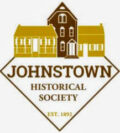The Drumm House
The Drumm House is one of six small houses Sir William Johnson had erected for his more important tenants. All were identical in design, 30 feet by 20 feet, one and one half stories high. They were a center hall design with two rooms on each floor, and all were painted yellow. In its two hundred plus years, the building has belonged to only three families, Judge Daniel Cady, father of Elizabeth Cady Stanton; the Peter Drumm family; and the Kilmer family from whom it was purchased by the Johnstown Historical Society in 1981.
When you take a tour of the building, you will begin in the Hallway. One of the interesting things you will see are two leather fire buckets hanging from the skirt of the landing. It was a village law in 1808 that each householder must have one fire bucket for each fireplace in his house. Does this sound familiar? Today we are required to have fire alarms in our homes.
Next, you will enter the kitchen or keeping room. This room was always busy since all household chores and most of the meals were prepared and consumed in this room. You will see a vast array of period kitchen tools and will notice that the scrub-top table is much lower than our tables today. In the 18th century, women were seldom over five feet tall and the average man was just slightly taller at five feet, two inches.
In the west parlor room, the furniture and fixtures are 18th century. Most were donated by descendants of Robert Cheadle, who was a surgeon in the Revolutionary War and settled in the Kingsboro Patent.
On the second floor, the west bedroom is the principal bed chamber. You will notice that the entry door is considerably lower and narrower than the doors on houses today. Most of the items on display have been received as donations. Each item has a story to tell. The mahogany baby cradle was supposedly used by Molly Brant at Johnson Hall. Vernon Steele, a local historian donated the dressing or shaving mirror used by his great, great grandfather.
The east bedroom displays a number of artifacts from the French and Indian War, the Revolutionary War, and the War of 1812. You will also see Dr. Cheadle’s medical instruments. There is a surveyor’s compass, reproductions of military uniforms, and Nick Stoner’s wooden headstone. Did you know that Lafayette visited Johnstown twice? Learn more about his visit on your tour.
For today’s weavers, there is the loom room which was added to the house by Peter Drumm in 1870. The loom was discovered and restored by Gene Valk and Maryann Shepard. You will learn the vocabulary of the weavers as you examine the tools of the trade.
